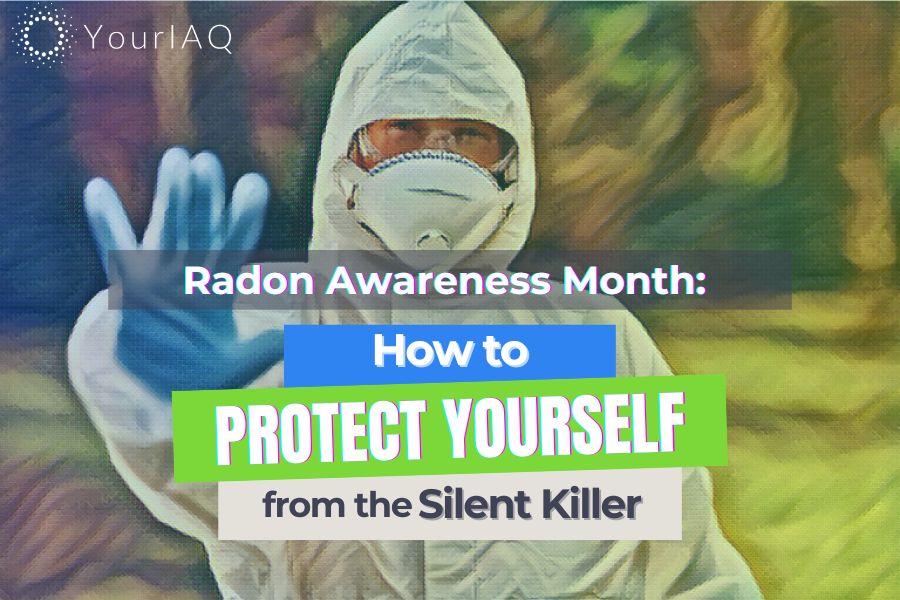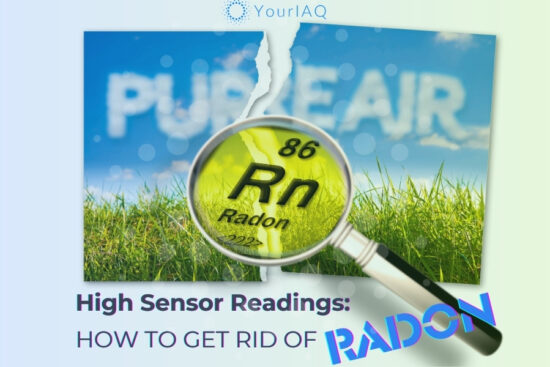
January marks National Radon Awareness Month, and there’s no better time to shed light on this invisible threat lurking in our homes. We’ve all heard of lung cancer from smoking, but what about the second leading cause – a sneaky gas hiding in basements and crawl spaces? In the spirit of #RadonAwarenessMonth, let’s equip ourselves with knowledge and action to breathe easy again!
What’s the Big Deal with Radon?
Radon is a colorless, odorless gas that can seep into homes from the ground. It’s a byproduct of natural uranium decay in soil and rock. The trouble with radon lies in its stealth – being invisible and odorless, it often goes unnoticed until it’s too late.
Now, low levels of radon are pretty harmless, but the problem arises when it gets trapped inside houses, reaching concentrations that damage your lungs. Exposure to high levels of radon poses a significant health risk, particularly an increased chance of developing lung cancer.
This risk is even more pronounced for non-smokers. Combining radon exposure with tobacco use further amplifies the danger. Understanding the risks is the first step in safeguarding yourself and your loved ones.
See also:
- Toxic Gases Inside: The Perils of Radon and Carbon Monoxide
- Radon Test Kits vs. Electronic Air Quality Monitors: Which is Right for You?
January: Radon Awareness Month
U.S. Environmental Protection Agency (EPA) estimates that radon is the second leading cause of lung cancer after smoking, responsible for about 21,000 lung cancer deaths each year in the United States. In fact, the National Toxicology Program includes Radon as a carcinogen, cementing its linkage to increased risk of lung cancer. This underlines the severity of the issue and emphasizes the need for awareness and action.
During January, the EPA and other organizations raise awareness about radon and the dangers it poses to health. Here are some things you can do to protect yourself from radon:
Test Your Home for Radon
An analysis of 13 years of radon concentration data collected from buildings in 46 US states and DC indicates that 35.4% of tests yielded results exceeding the EPA’s action level of 4.0 pCi/L. With such a high percentage of buildings exceeding the safe limit, it emphasizes the importance of regular radon testing and implementing mitigation strategies where necessary.
Given the widespread nature of this threat, the EPA emphasizes the importance of testing all homes for radon. You can easily purchase a radon test kit from most hardware stores or online retailers.
However, if you’re interested in long-term, ongoing protection from radon, consider getting an indoor air quality monitor that monitors for radon. IAQ monitors equipped with radon sensors can provide readings over time so you know if gas levels change.
Testing your home for radon is as simple as placing the kit in the lowest level of your home (usually the basement) or keeping your radon sensing monitor connected. Easy peasy!
Here’s a breakdown of radon levels and their implications:
| Radon Level (picocuries per liter of air) | Meaning | Recommended Action | |
| Below 2 pCi/L | Low Level | No immediate action is needed, but retesting every 2-4 years is recommended. Consider additional testing if significant changes occur in your home, like renovations or cracks in the foundation. | |
| 2 – 4 pCi/L | Elevated Level | Consider mitigation strategies to reduce radon levels. EPA recommends fixing homes at this level. Consult a qualified radon mitigation professional to discuss suitable options. | |
| Above 4 pCi/L | High Level | Take immediate action to reduce radon levels! This level significantly increases your risk of lung cancer. Implement mitigation measures as soon as possible and retest after remediation to ensure effectiveness. | |
You can always reach out to your state radon office for more information. They can also provide you with more information about radon and radon testing.
Pro-tip when buying a new home:
Inquire about radon-resistant construction methods when purchasing a new home. Ensure to discuss the incorporation of these techniques with the builder to guarantee that your prospective residence is equipped to minimize radon infiltration.
Reduce Radon Levels in Your Home
If your radon levels are high, take steps to reduce them. There are several ways to reduce radon levels in your home. Some options include:
- Ventilation: Opening windows and doors regularly can help lower radon levels, but this isn’t always practical or effective, especially in colder climates.
- Sealing cracks and entry points: Radon can sneak in through tiny cracks in your foundation and walls. Sealing these entry points can significantly reduce indoor radon levels.
- Radon mitigation systems: These professional systems involve installing a fan and piping to vent radon gas out of your home before it can build up.
What is a Radon Mitigation System?A Radon Mitigation System, also known as a radon reduction or radon remediation system, is a set of measures designed to reduce indoor radon levels. It is a specialized setup designed to effectively remove radon gas from your home and vent it safely to the outdoors. Here’s how it works:
Different Types of Mitigation Systems:Several types of radon mitigation systems exist, tailored to your home’s specific features and the location of radon entry points. Common options include:
Keep in mind:Do not attempt to install a radon mitigation system yourself. It requires a specialized skill set and access to specialized equipment. Hiring a qualified radon mitigation professional is your best option to ensure that your system is designed, installed, and tested correctly. The National Radon Program Services (NRPP) provides a directory of certified radon professionals in your local area. Utilize this resource to find qualified experts who can assess and address radon issues in your home. |
Spread the Word
Radon awareness doesn’t stop at your doorstep. Talk to your friends, family, and neighbors about radon. Or post information about radon on social media. Use the hashtag #RadonAwarenessMonth to reach and engage a wider audience.
During Radon Awareness Month, let’s collectively advocate for policies and initiatives that prioritize radon testing and mitigation in public spaces, schools, and workplaces.
The more people who are aware of radon, the more likely it is that homes will be tested and radon levels will be reduced.
Stay Informed
Regularly check the EPA and other trusted sources for the latest information and research on radon. You can also attend a radon awareness event. These events are often held during Radon Awareness Month and provide an excellent opportunity to learn more about radon and how to protect yourself.
Your Role in Radon Awareness Month
This National Radon Awareness Month, let’s make a lasting commitment to creating healthy indoor environments for ourselves and future generations. By testing, mitigating, and educating ourselves, we can ensure that every breath we take is a healthy one.
Frequently Asked Questions
Do I need to test my home for radon even if I don’t have a basement?
Yes, radon can infiltrate any level of your home, regardless of basement presence. Testing is crucial for determining your indoor air quality risk.
Are DIY radon test kits accurate?
Both DIY and professional kits can be effective, but long-term kits provide more accurate data. Ensure you follow the instructions carefully for reliable results.
Can I mitigate radon myself?
While DIY options exist for simple sealing procedures, for more complex mitigation systems, like fan installation, consulting a certified professional is highly recommended.
How much does radon mitigation cost?
The cost of radon mitigation depends on your home’s size and complexity but typically ranges from $2,500 to $10,000, with an average of around $5,000.






